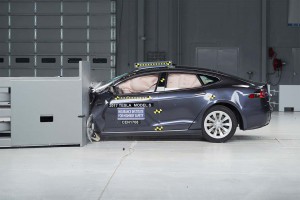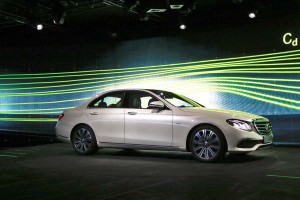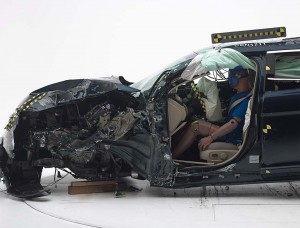
Tesla aces most tests but fell short in the small overlap crash - and the Model S had "poor" headlights.
The Tesla Model S was one of three large sedans to fall short in the latest round of crash tests by the Insurance Institute for Highway Safety.
The trade group also reports that three other large models fared extremely well during a series of tests for crash worthiness, earning the coveted IIHS Top Safety Pick+ ratings.
The poor performance by the Tesla Model S came amidst a series of problems for the electric vehicle maker, and at a time when CEO Elon Musk had hoped to focus on the upcoming launch of the maker’s first mainstream model, the Model 3. Production and sales are set to begin on Friday.
(Want to find the safest place to drive? Click Here to see which states are at the top – and bottom – of the list.)
The big Model S fared well in all but one test run by the IIHS, but that one is considered critical by the insurance industry’s auto safety arm, as the Small Overlap test is meant to replicate frequent highway incidents – such as when two cars clip one another traveling in opposite directions, or when a vehicle’s corner hits a telephone pole.
Surprisingly, the issue wasn’t the actual structure of the Tesla sedan, the IIHS noted. “The main problem with the performance of the Model S was that the safety belt let the dummy’s torso move too far forward, allowing the dummy’s head to strike the steering wheel hard through the airbag.”
The IIHS wound up testing two versions of the Model S, reflecting an update to the seatbelt system made in January. But, in the second test, there was greater intrusion into the driver’s space as a result of the crash. The group combined the results of the two tests and the Tesla Model S earned an “Acceptable” rating in the Small Overlap test. As a result, it fell short of what was needed to get the overall Top Safety Pick+ ratings
The IIHS also gave a “Poor” rating to the headlights on the Model S.
Though CEO Elon Musk has listed safety as one of his top priorities, Tesla tried to downplay the results of the IIHS tests, stating that, “IIHS and dozens of other private industry groups around the world have methods and motivations that suit their own subjective purposes.”
(A poor crash test is just one reason a good week has gone bad for Tesla. Click Here for the story.)
The other two models that missed the mark were the Ford Taurus and the Chevrolet Impala. Both also fell short in the Small Overlap test – though they did earn “Acceptable” ratings, like the Tesla — but fared well in most other tests.
The IIHS added strong words of praise for the Impala’s optional front crash prevention system. The Taurus has an optional front crash warning system but it cannot initiate braking automatically if the driver fails to respond in time. But the group also faulted the “Poor” performance of the Chevy and Ford headlights.
On the positive side, three of the large sedans received Top Safety Pick+ endorsements, IIHS research chief Dave Zuby saying they had “stellar” crash ratings:
- The Toyota Avalon was the only mainstream model on that list. It not only scored at the top in terms of crash tests, but improved its headlights and featured a well-rated front crash prevention system;
- The Lincoln Continental also scored well across the board though, ironically, the big luxury sedan’s optional HID headlights actually earned a “Poor” ratings;
- The Mercedes-Benz E-Class has been completely redesigned for 2017 and earned some of the best scores, across the board, in the latest round of testing.
Overall, “This group of large cars includes some with stellar ratings, but our small overlap front test remains a hurdle for some vehicles,” says Zuby.
(Click Here to find out why Hyundai killed off its big Azera sedan.)


